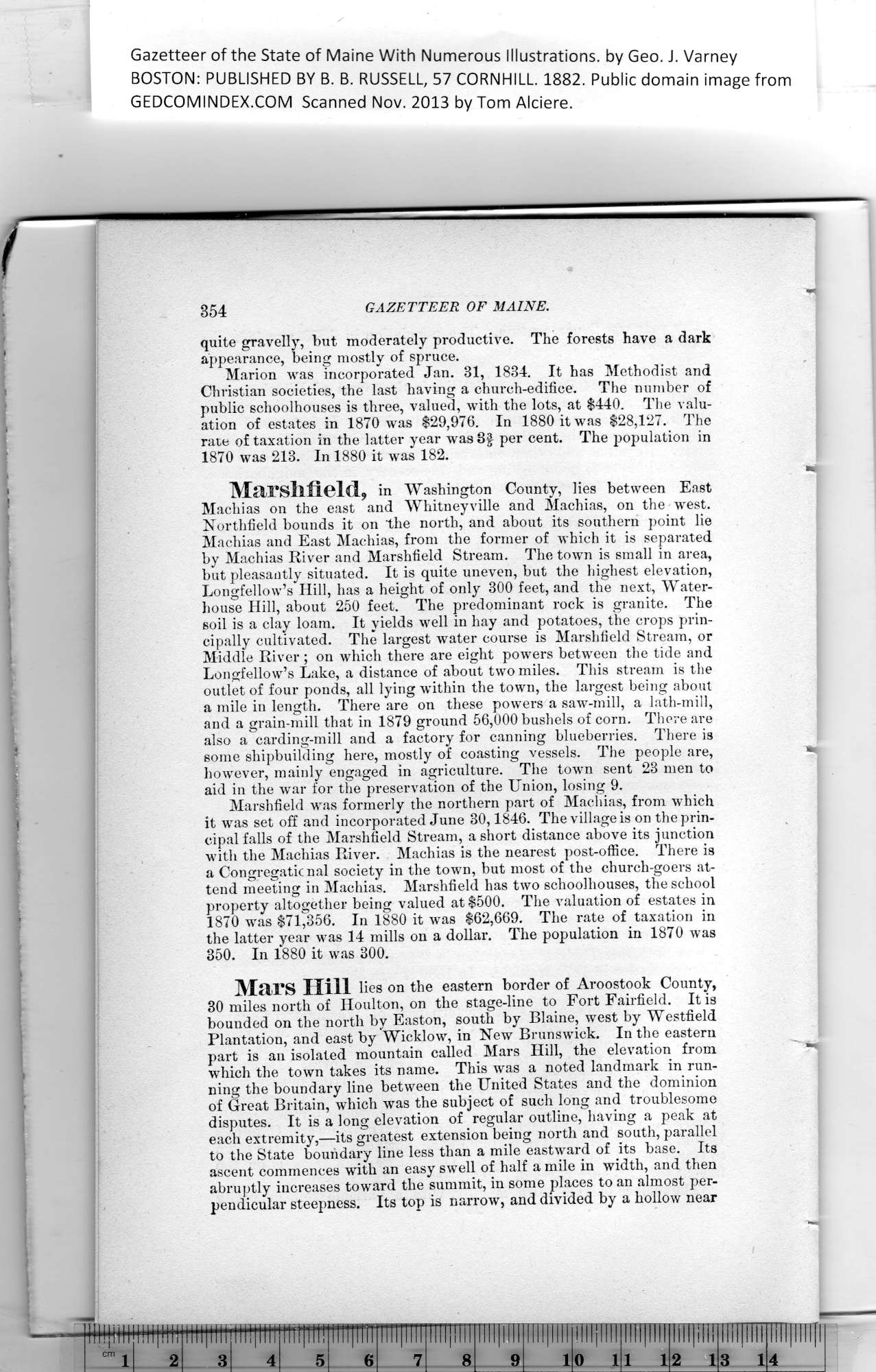|
Gazetteer of the State of Maine With Numerous Illustrations, by Geo. J. Varney
BOSTON. PUBLISHED BY B. B. RUSSELL, 57 CORNHILL. 1882. Public domain image from
354 GAZETTEER OF MAINE.
quite gravelly, but moderately productive. The forests have a dark
appearance, being mostly of spruce.
Marion was incorporated Jan. 31, 1834. It has Methodist and
Christian societies, the last having a church-edifice. The number of
public schoolhouses is three, valued, with the lots, at $440. The valu-
ation of estates in 1870 was $29,976. In 1880 it was $28,127. The
rate of taxation in the latter year was 8f per cent. The population in
1870 was 213. In 1880 it was 182.
*■
Marshfield, in Washington County, lies between East
Machias on the east and Whitneyville and Machias, on the west.
Northfield bounds it on 'the north, and about its southern point lie
Machias and East Machias, from the former of which it is separated
by Machias River and Marshfield Stream. The town is small in area,
but pleasantly situated. It is quite uneven, but the highest elevation,
Longfellow’s Hill, has a height of only 300 feet, and the next, Water-
house Hill, about 250 feet. The predominant rock is granite. The
6oil is a clay loam. It yields well in hay and potatoes, the crops prin-
cipally cultivated. The largest water course is Marshfield Stream, or
Middle River; on which there are eight powers between the tide and
Longfellow’s Lake, a distance of about two miles. This stream is the
outlet of four ponds, all lying within the town, the largest being about
a mile in length. There are on these powers a saw-mill, a lath-mill,
and a grain-mill that in 1879 ground 56,000 bushels of corn. There are
also a carding-mill and a factory for canning blueberries. There is
some shipbuilding here, mostly of coasting vessels. The people are, fc
however, mainly engaged in agriculture. The town sent 23 men to
aid in the war for the preservation of the Union, losing 9.
Marshfield was formerly the northern part of Machias, from which
it was set off and incorporated June 30,1846. The village is on the prin-
cipal falls of the Marshfield Stream, a short distance above its junction
with the Machias River. Machias is the nearest post-office. There is
a Congregational society in the town, but most of the church-goers at-
tend meeting in Machias. Marshfield has two schoolhouses, the school
property altogether being valued at $500. The valuation of estates in
1870 was $71,356. In 1880 it was $62,669. The rate of taxation in
the latter year was 14 mills on a dollar. The population in 1870 was
350. In 1880 it was 300.
Mars Hill lies on the eastern border of Aroostook County,
30 miles north of Houlton, on the stage-line to Fort Fairfield. It is
bounded on the north by Easton, south by Blaine, west by Westfield
Plantation, and east by Wicklow, in New Brunswick. In the eastern ^
part is an isolated mountain called Mars Hill, the elevation from ''"'I
which the town takes its name. This was a noted landmark in run-
ning the boundary line between the United States and the dominion
of Great Britain, which was the subject of such long and troublesome
disputes. It is a long elevation of regular outline, having a peak at
each extremity,—its greatest extension being north and south, parallel
to the State boundary line less than a mile eastward of its base. Its
ascent commences with an easy swell of half a mile in width, and then
abruptly increases toward the summit, in some places to an almost per-
pendicular steepness. Its top is narrow, and divided by a hollow near
PREVIOUS PAGE ... NEXT PAGE
This page was written in HTML using a program written in Python 3.2
|
